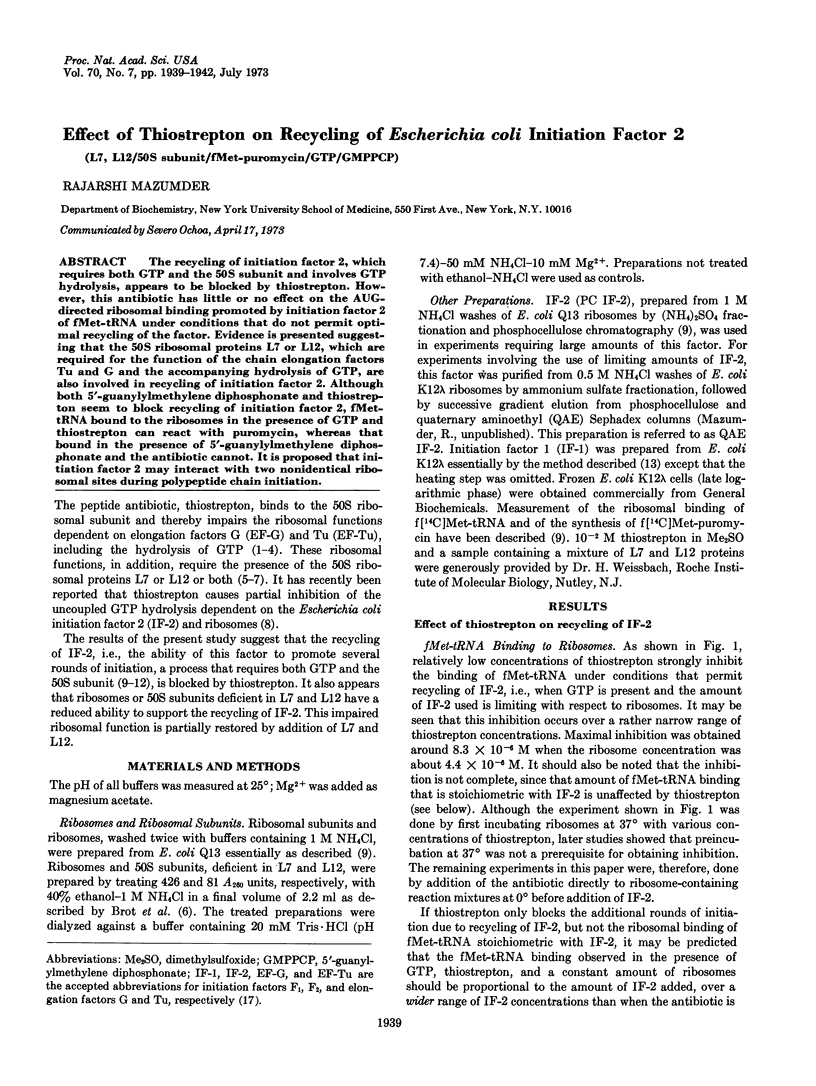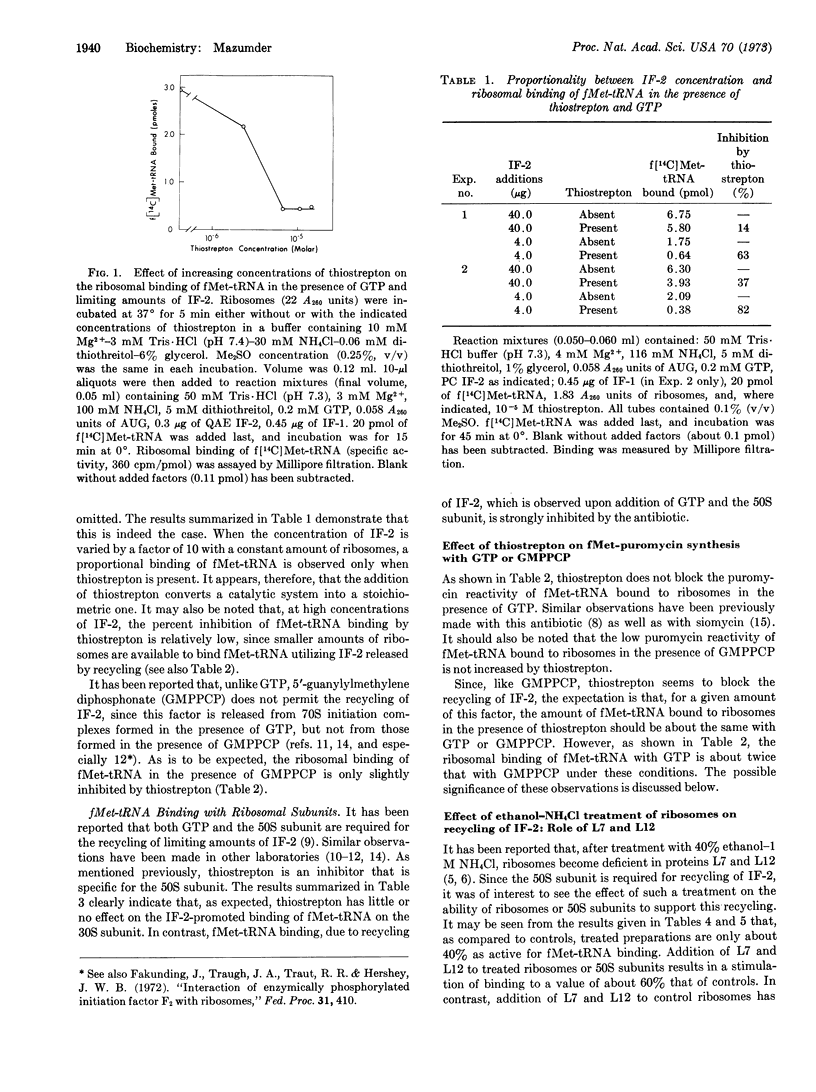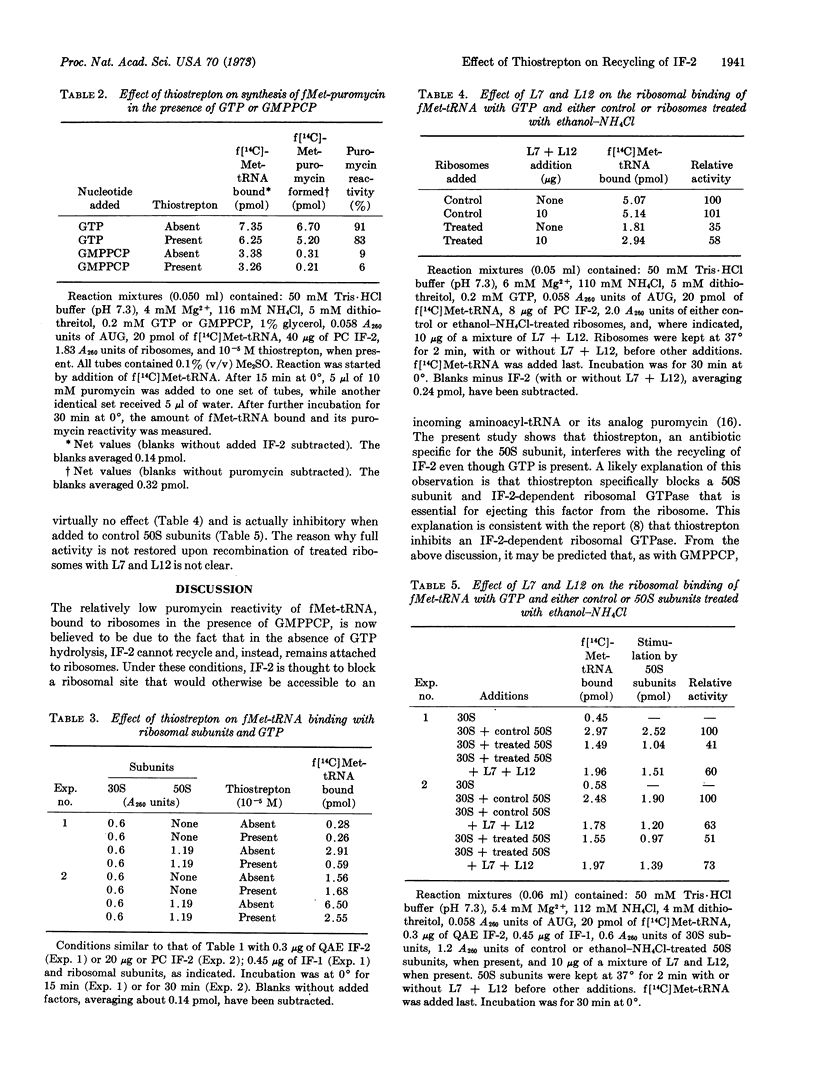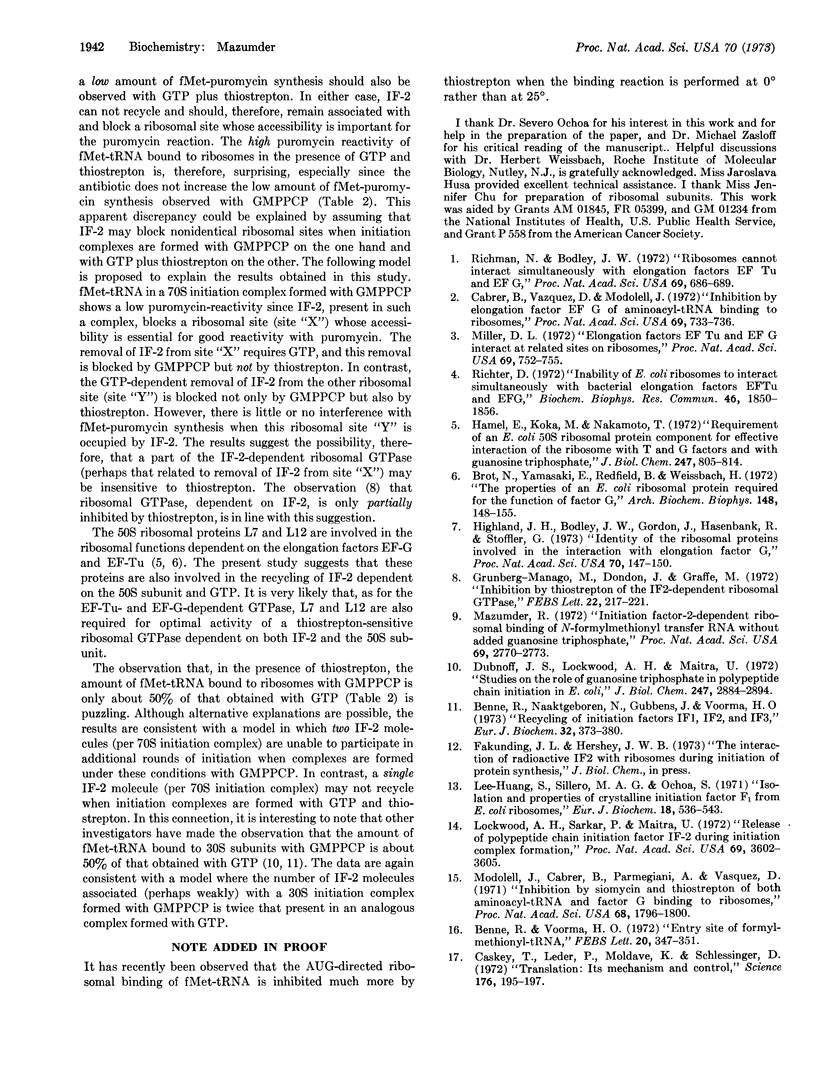Abstract
The recycling of initiation factor 2, which requires both GTP and the 50S subunit and involves GTP hydrolysis, appears to be blocked by thiostrepton. However, this antibiotic has little or no effect on the AUG-directed ribosomal binding promoted by initiation factor 2 of fMet-tRNA under conditions that do not permit optimal recycling of the factor. Evidence is presented suggesting that the 50S ribosomal proteins L7 or L12, which are required for the function of the chain elongation factors Tu and G and the accompanying hydrolysis of GTP, are also involved in recycling of initiation factor 2. Although both 5′-guanylylmethylene diphosphonate and thiostrepton seem to block recycling of initiation factor 2, fMet-tRNA bound to the ribosomes in the presence of GTP and thiostrepton can react with puromycin, whereas that bound in the presence of 5′-guanylylmethylene diphosphonate and the antibiotic cannot. It is proposed that initiation factor 2 may interact with two nonidentical ribosomal sites during polypeptide chain initiation.
Keywords: L7, L12; 50S subunit; fMet-puromycin; GTP; GMPPCP
Full text
PDF



Selected References
These references are in PubMed. This may not be the complete list of references from this article.
- Benne R., Naaktgeboren N., Gubbens J., Voorma H. O. Recycling of initiation factors IF-1, IF-2 and IF-3. Eur J Biochem. 1973 Jan 15;32(2):372–380. doi: 10.1111/j.1432-1033.1973.tb02619.x. [DOI] [PubMed] [Google Scholar]
- Benne R., Voorma H. O. Entry site of formylmethionyl-tRNA. FEBS Lett. 1972 Feb 15;20(3):347–351. doi: 10.1016/0014-5793(72)80104-2. [DOI] [PubMed] [Google Scholar]
- Brot N., Yamasaki E., Redfield B., Weissbach H. The properties of an E. coli ribosomal protein required for the function of factor G. Arch Biochem Biophys. 1972 Jan;148(1):148–155. doi: 10.1016/0003-9861(72)90125-7. [DOI] [PubMed] [Google Scholar]
- Cabrer B., Vázquez D., Modolell J. Inhibition by elongation factor EF G of aminoacyl-tRNA binding to ribosomes. Proc Natl Acad Sci U S A. 1972 Mar;69(3):733–736. doi: 10.1073/pnas.69.3.733. [DOI] [PMC free article] [PubMed] [Google Scholar]
- Caskey T., Leder P., Moldave K., Schlessinger D. Translation: its mechanism and control. Science. 1972 Apr 14;176(4031):195–197. doi: 10.1126/science.176.4031.195. [DOI] [PubMed] [Google Scholar]
- Dubnoff J. S., Lockwood A. H., Maitra U. Studies on the role of guanosine triphosphate in polypeptide chain initiation in Escherichia coli. J Biol Chem. 1972 May 10;247(9):2884–2894. [PubMed] [Google Scholar]
- Grunberg-Manago M., Dondon J., Graffe M. Inhibition by thiostrepton of the IF-2-dependent ribosomal GTPase. FEBS Lett. 1972 May 1;22(2):217–221. doi: 10.1016/0014-5793(72)80049-8. [DOI] [PubMed] [Google Scholar]
- Hamel E., Koka M., Nakamoto T. Requirement of an Escherichia coli 50 S ribosomal protein component for effective interaction of the ribosome with T and G factors and with guanosine triphosphate. J Biol Chem. 1972 Feb 10;247(3):805–814. [PubMed] [Google Scholar]
- Highland J. H., Bodley J. W., Gordon J., Hasenbank R., Stöffler G. Identity of the ribosomal proteins involved in the interaction with elongation factor G. Proc Natl Acad Sci U S A. 1973 Jan;70(1):147–150. doi: 10.1073/pnas.70.1.147. [DOI] [PMC free article] [PubMed] [Google Scholar]
- Lee-Huang S., Sillero M. A., Ochoa S. Isolation and properties of crystalline initiation factor F1 from Escherichia coli ribosomes. Eur J Biochem. 1971 Feb;18(4):536–543. doi: 10.1111/j.1432-1033.1971.tb01274.x. [DOI] [PubMed] [Google Scholar]
- Lockwood A. H., Sarkar P., Maitra U. Release of polypeptide chain initiation factor IF-2 during initiation complex formation. Proc Natl Acad Sci U S A. 1972 Dec;69(12):3602–3605. doi: 10.1073/pnas.69.12.3602. [DOI] [PMC free article] [PubMed] [Google Scholar]
- Mazumder R. Initiation factor 2-dependent ribosomal binding of N-formylmethionyl-transfer RNA without added guanosine triphosphate. Proc Natl Acad Sci U S A. 1972 Oct;69(10):2770–2773. doi: 10.1073/pnas.69.10.2770. [DOI] [PMC free article] [PubMed] [Google Scholar]
- Miller D. L. Elongation factors EF Tu and EF G interact at related sites on ribosomes. Proc Natl Acad Sci U S A. 1972 Mar;69(3):752–755. doi: 10.1073/pnas.69.3.752. [DOI] [PMC free article] [PubMed] [Google Scholar]
- Modolell J., Cabrer B., Parmeggiani A., Vazquez D. Inhibition by siomycin and thiostrepton of both aminoacyl-tRNA and factor G binding to ribosomes. Proc Natl Acad Sci U S A. 1971 Aug;68(8):1796–1800. doi: 10.1073/pnas.68.8.1796. [DOI] [PMC free article] [PubMed] [Google Scholar]
- Richman N., Bodley J. W. Ribosomes cannot interact simultaneously with elongation factors EF Tu and EF G. Proc Natl Acad Sci U S A. 1972 Mar;69(3):686–689. doi: 10.1073/pnas.69.3.686. [DOI] [PMC free article] [PubMed] [Google Scholar]
- Richter D. Inability of E. coli ribosomes to interact simultaneously with the bacterial elongation factors EF Tu and EF G. Biochem Biophys Res Commun. 1972 Mar 10;46(5):1850–1856. doi: 10.1016/0006-291x(72)90061-7. [DOI] [PubMed] [Google Scholar]


